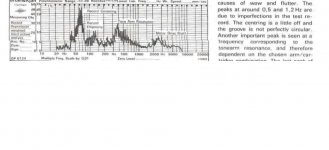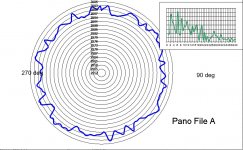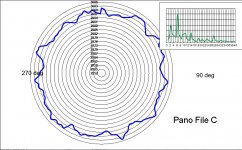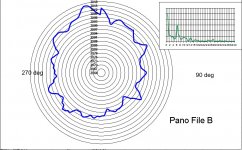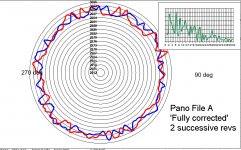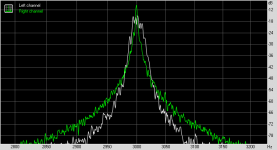I suspect not even many vinyl-die-hards would decline the opportunity to fix pitch variation from eccentricity and other causes...... record mis-centring is the largest cause of once per platter rev variation by far, IME.........
LD
Hi all,
Record eccentricity is undoubtedly the greatest source of speed variation in absolute terms. However if you consider human perception the once per revolution variation is not that perceptible. C weighting of wow and flutter takes human perception into account. A 0.55hz frequency pitch variation is 10dB less audible than the same level of variation at 4hz, were we are most sensitive to pitch variation, when viewed in C weighting. Pitch variation due to stylus scrubbing due to warps may well be more audible than the gross variation due to eccentricity.
Niffy
Last edited:
I thought warp was 8Hz? Whilst in total agreement that 4Hz can be picked up at vanishingly small levels, the 0.55Hz effect is far higher than all others. Plus warp can and should be dealt with.
I guess we are in violent agreement that there is a pecking order though
I guess we are in violent agreement that there is a pecking order though
Attachments
Thanks, Pano.Here are TT files that davidsrb posted that have been run thru the Capstan software.
3 files. Non-corrected, full correction, smoothed correction (not necessarily in that order.) Let's see what they look like in a polar plot. How much - if anything - was detected and fixed?
Here's the polar plots. To keep it simple, just one revolution per plot and the same start time in the files.
Seems obvious which is the 'non-corrected': file B. The others apparently have interesting artefacts, but seem to have corrected the 0.55Hz eccentricity.......if not the circa 6Hz element.......or sort of scrambled it spectrally.
The attachments have appeared in a strange order, A,C,B so check the labels on the images !
Interesting ?
LD
Attachments
Last edited:
Careful about the scale. "A" is the best at +/- 3Hz variationAfter correcting, the stability of arm/cartridge is getting worse(green curve). What does this mean? I understand it is all in digital domain. But how does this have effect on listening? Does the correction make things better or worse?
Yes, IMO/IME it's true that 2-20Hz pitch warble is far more audible than 0.55Hz eccentricity.Hi all,
Record eccentricity is undoubtedly the greatest source of speed variation in absolute terms. However if you consider human perception the once per revolution variation is not that perceptible. C weighting of wow and flutter takes human perception into account. A 0.55hz frequency pitch variation is 10dB less audible than the same level of variation at 4hz, were we are most sensitive to pitch variation, when viewed in C weighting. Pitch variation due to stylus scrubbing due to warps may well be more audible than the gross variation due to eccentricity.
Niffy
But, in a well tempered TT, one can pretty much reduce everything except eccentricty/centring, to close to the audible threshold. And personally, 0.55Hz pitch variation does drive me nuts on a badly centred record.
I chose the scale of the polar plot so that one pair of tramlines represents the so-called threshold of audibility to warble tones. It's easy to check: listen to the files ! Speakers are best, 3kHzdoes some weird spacial cue things - also check the effect of moving one's head and hear the pitch variation vanish when it's moving !
In file A (which isn't music, of course) on that test, it seems the 0.55Hz variation was pretty much eliminated and the 6Hz component pretty much randomly scrambled spectrally, leaving what looks like a quasi-random residual variation. Which methinks should be an improvement on the mostly 6Hz that was there in the first place. The magnitude of this residual variation, as I understand it, is still above the audible threshold in theory, and can be 'beaten' by a well tempered TT without correction, IME. I think it's impressive.Thanks Lucky! Interesting indeed. Maybe Capstan just doesn't fix fluctuations that tiny.
A= Full default correction
B= No correction
C= 30% Smoothed correction
Here's a polar plot of 2 successive rotations of file A (fully corrected), which seems to show the quasi-random nature of the residue.
LD
Attachments
The motor rotation is not necessarily related to the platter rotation by an integer and would scramble the peaks in successive rotations.Here's a polar plot of 2 successive rotations of file A (fully corrected), which seems to show the quasi-random nature of the residue.
LD
Only DD turntables are certain to repeat cogging artifacts at the same angle
Yes. But after correction it doesn't look like one can 'rotate' the two patterns and obtain a reasonable fit, plus the spectral content is significantly different after correction. Those patterns probably aren't truly random because they have roots in a non-random stimulus, however they do appear quasi-random, IMO, moreso than normal.
I agree the 6Hz or so content is probably cogging, BTW. Actually the raw file is a very good test case, since it has several elements in fair doses.
LD
I agree the 6Hz or so content is probably cogging, BTW. Actually the raw file is a very good test case, since it has several elements in fair doses.
LD
Careful about the scale. "A" is the best at +/- 3Hz variation
I understand A is the best from the blue polar plot, but look the green plot on right up corner. Isn't A getting worse?
Last edited:
I'm a little surprised that Capstan removed the 0.55Hz almost completely, but left the 6Hz. Or scrambled it. Perhaps the 6Hz ripple is below the threshold level of what the software considers important.
In their demo video, they show a section where the software tries to remove the vibrato on a violin solo. The video demonstrates how to avoid that. But I feel that the cogging or whatever it is in this files is just too small. Or maybe Capstan needs a more complex signal to figure it out. Still interesting to see what other software detects.
In their demo video, they show a section where the software tries to remove the vibrato on a violin solo. The video demonstrates how to avoid that. But I feel that the cogging or whatever it is in this files is just too small. Or maybe Capstan needs a more complex signal to figure it out. Still interesting to see what other software detects.
Appols - the spectrum inset auto-scales so it's not possible to compare any two insets.Hard to tell when there is no scale
This is historic left over from when I was struggling to meaningfully calibrate the spectral content, and for me it's just useful as a pointer as to the spectral source of pitch deviation......
It's also a way of coping with being swamped by 0.55Hz content - so when that is removed the autoscale kicks up the remaining content.
So don't try to compare amplitude of spectral insets - they auto-scale and aren't calibrated (!)
LD
Using the tools I have - FFT - I took a look at the original and the fully corrected files and the low end is almost identical. Up at 3K and its harmonics is where we see the real difference. The correction has tightened up the 3K tone nicely, as well as its harmonics.
Attachments
More likely too high a frequency. Capstan was created to remove low speed tape stretching and mechanical artifacts. If it was too fast, it would be sure to remove vibrato and tremeloI'm a little surprised that Capstan removed the 0.55Hz almost completely, but left the 6Hz. Or scrambled it. Perhaps the 6Hz ripple is below the threshold level of what the software considers important.
It's based on whatever signal the software is set to lock onto. I recall seeing the news blurb when Capstan was announced, the idea was it locked onto the ultrasonic tape bias signal, which actually gets recorded and plays back at 15IPS tape speed. I presume it could be locked on to other fixed frequencies that may be present, such as residual 50/60Hz hum or the 15,750 Hz of US analog TV.More likely too high a frequency. Capstan was created to remove low speed tape stretching and mechanical artifacts. If it was too fast, it would be sure to remove vibrato and tremelo
- Status
- This old topic is closed. If you want to reopen this topic, contact a moderator using the "Report Post" button.
- Home
- Source & Line
- Analogue Source
- Turntable speed stabilty
